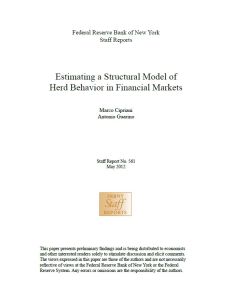Join getAbstract to access the summary!

Join getAbstract to access the summary!
Marco Cipriani and Antonio Guarino
Estimating a Structural Model of Herd Behavior in Financial Markets
Federal Reserve Bank of New York, 2012
What's inside?
Bulls may sometimes run on Wall Street, but do herds control the market?
Recommendation
Researchers Marco Cipriani and Antonio Guarino present an innovative approach to the study of “herding,” traders’ tendency to base their transactions on market movements even if those actions contradict the traders’ information. Cipriani and Guarino’s model is the first to blend “social learning” theories of motivation with trading statistics to derive an understanding of why traders act as they do. getAbstract suggests their scholarly work to academics, regulators and financial services professionals interested in cutting-edge research on stock market behavior.
Summary
About the Authors
Marco Cipriani works at the Federal Reserve Bank of New York. Antonio Guarino is a reader at the University College London.


















Comment on this summary